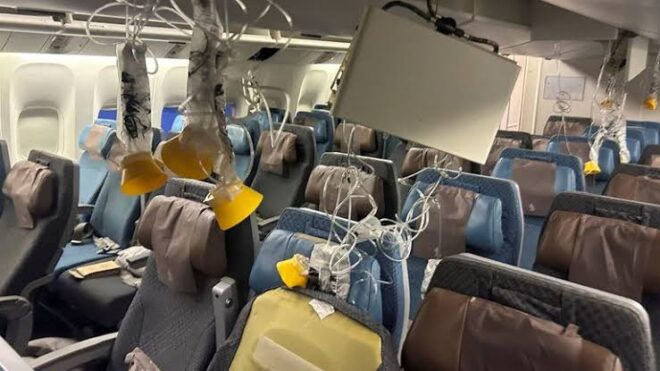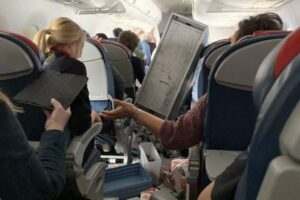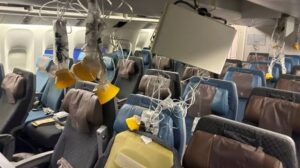
On Monday, an Air Europa flight was struck by severe turbulence en route from Spain to Uruguay, leaving 23 passengers hospitalized — including several with neck and skull fractures.





It was the second incident in just over a month where turbulence encountered during flight resulted in serious injuries. In May, a Singapore Airlines flight that ran into a patch of bad turbulence left one man dead and more than 100 people injured.
Turbulence events severe enough to cause injury are “extremely rare,” experts tell the Star, but evidence suggests they may be becoming more common.
Research forecasts the incidents of air turbulence to increase in numbers and severity, largely as a result of climate change.
“I’ve come across a number of studies that use current weather modelling and prediction models to see how climate change can affect incidences of turbulence,” said Serhiy Yarusevych, a professor of Mechanical and Mechatronics Engineering at the University of Waterloo. “They seem to indicate that there’s a very strong correlation of this increase.”
Severe air turbulence leads to serious injuries

On May 21, a Singapore Airlines flight flying from London to Singapore ran into bad turbulence over the Andaman Sea, hurling items, passengers and crew members about the cabin and sending the Boeing 777 plane on a 1,800 metre descent in about three minutes — after which it made an emergency landing in Thailand.
In the aftermath of the chaos, more than 100 people aboard the 211 passenger and 18 crew member flight were hospitalized, some with spinal cord, skull and brain injuries; 20 were rushed to intensive care and a 73-year-old British man died, possibly of a heart attack, Thai authorities reported.
A month later, on Monday, a similar bout of turbulence struck an Air Europa flight, forcing the Boeing 787 to divert to Brazil. Thirty-six passengers were treated for injuries, with 23 taken to hospital, according to the New York Times.
Videos posted to social media showed the damaged interior of the cabin as well as passengers lying in the aisle, some in neck braces. A person was seen dangling from an overhead compartment; it’s unclear how they got there.
Despite these recent incidents, it’s relatively rare that turbulence leads to serious harm. Between 2009 and 2022, the U.S. Federal Aviation Administration recorded just 163 “serious turbulence injuries” — requiring hospital stays of at least two days — most of which were among crew members. 2022 saw 17 total incidents, while six were recorded in 2021.
What causes airplane turbulence?

According to Yarusevych, air turbulence is caused by “disturbances in the ambient air through which the aircraft is flying” — essentially, pockets of swirling air moving in an unpredictable fashion. As the airplane travels through these pockets, they’re subject to the swirling forces, causing the cabin to shake.
Airplane turbulence has a myriad of different causes; in the lower atmosphere, it tends to follow storms, for example, which can be easily seen and avoided through the use of weather radars, according to John Hansman, a professor of aeronautics and astronautics at MIT and the director of the MIT International Center for Air Transportation.
More problematic is what’s known as clear-air turbulence, which tends to form at higher altitudes and aren’t associated with visible weather patterns — meaning pilots have little chance of noticing and avoiding these on their own, Hansman continued.
These often break out near the jet stream — great rivers of fast-flowing air in the upper atmosphere. As the fast-moving current grinds against the surrounding, slower moving air masses, it sparks disturbances in the atmosphere, causing swirling eddies to form and leading nearby aircraft to experience turbulence, he explained.
“It’s not easy to detect, particularly at distances,” Hansman continued. “There’s a system, which is essentially word-of-mouth — if an airplane goes through turbulence, they will typically report it and try to change altitude. And then air traffic control in most areas will let other airplanes know that there is a report of turbulence ahead.”
Is airplane turbulence getting worse?
A number of studies in the last few years have marked a clear relationship between climate change and the growing prevalence of air turbulence.

For example, according to research from 2017, should carbon dioxide levels in the atmosphere double, light turbulence experienced by transatlantic flights during wintertime is expected to increase by roughly 59 per cent, moderate turbulence by 94 per cent and severe turbulence by 149 per cent.
Meanwhile, a 2019 study reported a 15 per cent increase in vertical wind shear strength — the change in wind speed with height — over the North Atlantic between 1979 and 2017, which is expected to increase the amount of turbulence.
Most recently, a paper published last year that screened through four decades of clear-air turbulence trends discovered “clear evidence of large increases” of turbulence at cruising altitudes in certain regions, including over the continental U.S. and parts of the North Atlantic.
“This is not too difficult to intuitively agree with because studies have shown very clearly that the majority of severe weather events that we’ve been observing and tracking over the past decade are attributed to, or aggravated by, the effect of human activity on weather and climate,” Yarusevych noted.
“Of course, these severe weather events are typically associated with significant generation of atmospheric turbulence.”

Hansman is more skeptical of the connection. “It’s not clear that the amount of turbulence is on the rise, or that the mechanisms are on the rise. This is very hard to measure,” he said.
That said, “it is clear that with global warming and the warming in the oceans, et cetera, the locations where the turbulence might be may be shifting,” Hansman continued. Instead of turbulence events increasing as a whole, it’s possible the regions where extreme turbulence is encountered are changing, leading to the impression that it’s on the rise.
“The other thing to be careful of when you look at the reported incidents over the past 30 or 40 years, there’s been a significant increase in the amount of air traffic,” he said. “So you have more incidents occurring, but it may not be that the atmosphere is changing but that there’s more people flying.”
What are airlines doing about turbulence?
In a statement to the Star, a spokesperson for WestJet noted their flight planning teams “have access to a multitude of predicative weather sources” and that flight crews are “provided with updated turbulence and weather reports via constant communication with our operations control centre and air traffic control, as well as reports from other aircraft.”
They also noted the airline is part of the International Air Transport Association Turbulence Aware platform alluded to by Hansman, which shares access to “accurate, worldwide aircraft-generated data related to turbulence.”
Meanwhile, a spokesperson for CUPE 4070, the union that represents flight attendants at WestJet, noted that “WestJet has had some minimal training on the subject for cabin crew members.”
“It is a concern to WestJet Cabin Crew, as service needs are being added to and that keeps crew in the aisles, and not safe in the galleys,” they said. “It’s our advice to all passengers to take seatbelt signs very seriously and to wear seatbelts at all times when seated on the aircraft.”
Yarusevych noted that progress is being made on developing technology capable of reliably detecting clear-air turbulence, but that “the technology is still more of a laboratory level … and due to the sheer number of aircraft that will need to be retrofitted, it will take quite a bit of time.”
Fortunately, modern airplanes are designed to withstand even severe turbulence — but that doesn’t prevent passengers, crew and items getting tossed about by the forces, Hansman said, urging passengers to wear their seatbelts.
“People that don’t have their seatbelts on could end up hit the ceiling, et cetera, like (during the most recent two incidents),” he said. “That’s where most of the injuries came from.”